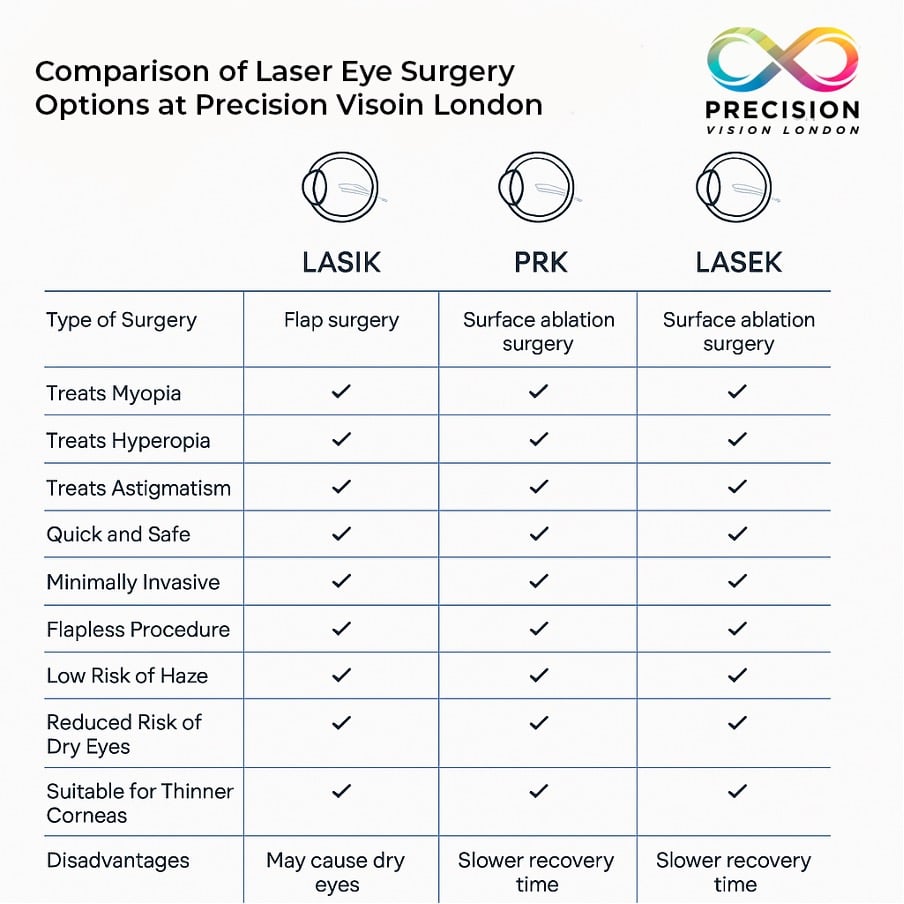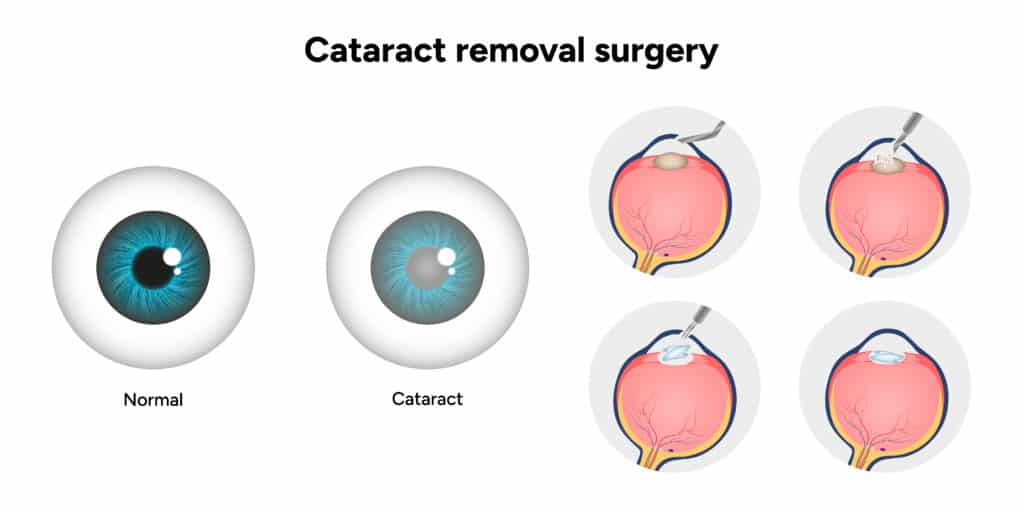Vision correction changes lives at every stage. This applies whether you’re in your twenties and want freedom from glasses or face age-related changes later in life. Most eye surgeons suggest laser vision correction between ages 25 and 40. This timing works best because most people’s prescriptions become stable during this period. The results can provide clear vision for decades.
Your vision correction needs change as you age. Laser vision correction helps people in their 20s and 30s avoid the daily struggles with glasses and contact lenses. People in their 40s who experience presbyopia might need different solutions. SMILE has become a popular choice among patients. This minimally invasive treatment causes no pain and lets patients recover quickly.
This piece outlines the best vision correction options based on your age group and lifestyle. We’ll look at treatments from LASIK and LASEK to Refractive Lens Exchange. These procedures give lasting results – patients often enjoy clear vision for years or decades after their treatment.

Vision Correction in Your 20s and 30s
Your twenties and thirties give you the perfect chance to get laser vision correction. These decades mark a time when your eyes reach their best stability. This makes it an excellent time to think over permanent solutions for vision problems.
Why this is the ideal age for laser vision correction
Eye specialists call the mid-20s to 30s the best time for laser vision correction because your prescription has usually stabilised. Your body and vision start to balance out after age 18, with most prescriptions stabilising by the mid to late 20s. Your corneas stay healthier and more resilient at this age. This allows better healing and long-term results.
LASIK, LASEK, and SMILE: What’s best for you?
Your early adult years offer several excellent vision correction options:
- LASIK (Laser-assisted in situ keratomileusis): This common procedure creates a thin flap in the cornea before reshaping the tissue underneath. Most patients see better vision within 24-48 hours.
- LASEK (Laser-assisted subepithelial keratectomy): This method removes the outer corneal layer entirely. While doctors use it less now, it helps people with thinner corneas. Recovery takes longer, typically 5-7 days.
- SMILE (Small Incision Lenticule Extraction): This minimally invasive option uses a small incision instead of creating a flap. People with dry eyes or those who play contact sports benefit from this procedure.
Prescription stability and eligibility
Your prescription should stay stable for at least 12-24 months to qualify for laser vision correction. Clinics want your prescription to show minimal changes (less than 0.5D) in the last year. This stability requirement explains why surgeons won’t perform these procedures on patients under 18 years old.
Lifestyle benefits: sports, travel, and work
Clear vision brings amazing benefits during your active years. You can enjoy sports and swimming without glasses or contacts getting in the way. Your work life improves with clear vision that increases efficiency and confidence. On top of that, it reduces your risk of eye infections that come from wearing contact lenses long-term.

What to expect from the procedure at this age
The procedure takes just minutes, and results come faster. LASIK helps 99% of people achieve 20/40 vision or better. Young adults usually return to work within 1-2 days after LASIK or SMILE procedures. Temporary dry eyes remain the most common side effect, lasting weeks to months.
Vision Correction in Your 40s and 50s
Your vision changes drastically when you reach your 40s due to presbyopia. This natural ageing process affects everyone and makes it harder to see things up close.
Understanding presbyopia and near vision loss
The eye’s natural crystalline lens becomes less flexible around age 40, causing presbyopia. You might catch yourself holding books far away or squinting at your phone screen and restaurant menus. By 50, most people can’t focus on both near and middle-distance objects, which leaves them with fixed-focus vision.
Presbyond and other advanced options
PRESBYOND Laser Blended Vision stands out as one of the most important breakthroughs in presbyopia treatment. The technique enhances focus depth by adjusting each eye differently – one eye works better for distance but still helps with near vision, while the other eye focuses on close objects but assists with distance vision. PRESBYOND’s success rate is remarkable – about 97% of patients adapt well to it, while traditional monovision treatments work for only 60% of people.
Balancing distance and reading vision
PRESBYOND offers seamless vision from near to far distances, unlike traditional monovision. Each patient’s treatment plan is customised based on their eye’s wavefront data and functional age. The results speak for themselves – patients can read regular newsprint right after treatment, and more than 90% can read even the tiniest print on medicine bottles.
How vision correction surgery cost varies with age
You’ll pay more for presbyopia-specific treatments than standard laser vision correction. PRESBYOND costs about £2,895 per eye because of its advanced technology and specialised approach. Lens replacement surgery, which doctors often recommend to patients over 50, costs between £1,995 and £3,755 per eye for monofocal options. Multifocal options range from £3,195 to £4,725.
Vision Correction After 60
Vision correction in your sixties shifts focus from simple refractive errors to natural lens changes. This life stage brings its own set of challenges, but several effective solutions exist.
Cataracts and age-related vision changes
Most people develop some lens clouding by 60, and half of those over 75 experience cataracts. The natural ageing process makes your lens stiffer and cloudier, which affects how clearly you see. Glaucoma, age-related macular degeneration (AMD), and ongoing presbyopia are other common conditions that develop with age.

Replacement Lens Exchange (RLE) explained
RLE stands out as the best choice for most patients over 60. The procedure swaps your natural lens with a synthetic implant. Like in cataract surgery, RLE takes 30-60 minutes as a day case procedure. Patients usually recover in 3-4 days and can get back to their normal routine quickly.
Benefits of intraocular lenses (IOLs)
Today’s IOLs come with several key advantages:
- Monofocal lenses give you clear vision at one specific distance
- Multifocal lenses help you see both near and far, so you might not need glasses
- Toric lenses fix astigmatism and other vision problems
After surgery, patients notice better colour perception, less glare at night, and improved quality of life.
Is laser vision correction still an option?
Laser eye treatment doesn’t have an official upper age limit. But cataracts become more common after 60, which makes lens-based procedures a better fit. Laser vision correction still works well for people without cataracts who have healthy eye surfaces.
Eye health considerations for seniors
Your eye health needs more attention after 60. The American Academy of Ophthalmology suggests yearly eye exams for anyone over 50. These check-ups spot early signs of age-related conditions like glaucoma, AMD, and diabetic retinopathy before you notice any symptoms.
Why Personalised Care Matters at Every Age
Personalised vision care is the life-blood of successful eye treatment at every life stage. No two eyes are similar. This makes customised approaches vital for the best results.
The importance of a detailed eye assessment
Precision Vision London’s complete pre-operative assessments give a full picture of your eye health through:
- Complete refractive evaluations and detailed corneal mapping
- Assessment of tear production and dry eye risk
- Pupil size measurement in various light conditions
These detailed evaluations can detect subtle conditions that might affect treatment success. Early intervention becomes possible before problems develop.
Tailoring treatments to your lifestyle and goals
Each patient’s visual needs differ substantially. Therefore, customised treatment plans take into account both your prescription and lifestyle factors that shape your specific requirements. The clinic’s Advanced Wavefront technology creates detailed corneal maps and tailors correction to each eye’s unique features.
How Precision Vision London will give safety and results
Safety remains at the heart of Precision Vision London’s approach. The clinic uses state-of-the-art equipment that gets upgraded every three years. All surgeons are UK-trained with over 10 years of specialist experience. Your aftercare package has medication instructions, protective measures, and scheduled follow-ups. Support is available whenever you need to ask questions.
Ready to find the right option for your age and lifestyle? Book Your Expert Eye Consultation Today
Conclusion
Vision correction options evolve as your visual needs change throughout life. Your twenties and thirties present an ideal chance to consider laser vision correction procedures like LASIK, LASEK, and SMILE. This timing works well because your prescription has likely stabilised. When you reach your forties and fifties, presbyopia creates new challenges. PRESBYOND Laser Blended Vision will give a vital balance between distance and reading vision.
Lens-based procedures like Replacement Lens Exchange become more suitable after sixty when cataracts develop. Laser options still work for people with good eye surface health. Your individual eye health determines the best treatment path, regardless of age-specific suggestions. A full picture before surgery helps identify possible complications and creates personalised treatment plans.
The path to clearer vision substantially depends on care that matches your specific needs and lifestyle. Your tear production, pupil size, and corneal mapping shape which procedure will give the best results. It also takes detailed aftercare to keep you safe while healing and achieve the best long-term results.
Clear vision is possible at any age. We customise solutions from LASIK to advanced lens surgery for everyone. Ready to discover the right option for your age and lifestyle? Book Your Expert Eye Consultation Today.
Your eyes deserve expert care at every stage of life. The right procedure at the right time can transform your quality of life and free you from glasses and contact lenses. Advanced technology and experienced surgeons help create lasting results. These changes can last for decades, making vision correction one of the best investments in your long-term wellbeing.
FAQs
Q1. Is there an age limit for vision correction surgery? There’s no strict upper age limit for vision correction surgery. However, the most suitable procedure may change as you age. While laser eye surgery is often recommended for those in their 20s and 30s, lens-based procedures like Replacement Lens Exchange are typically more appropriate for individuals over 60.
Q2. What are the main types of vision correction procedures available? The primary types of vision correction procedures include LASIK, LASEK, and SMILE for laser-based corrections, and Replacement Lens Exchange (RLE) for lens-based corrections. Each procedure has its own benefits and is suited to different age groups and eye conditions.
Q3. Can age-related vision changes be corrected? Yes, age-related vision changes can be corrected. For presbyopia, which typically develops in your 40s, treatments like PRESBYOND Laser Blended Vision can help. For older adults experiencing cataracts, lens replacement surgery can significantly improve vision.
Q4. How does the cost of vision correction surgery vary with age? The cost of vision correction surgery tends to increase with age as more advanced procedures are often required. For instance, PRESBYOND for presbyopia correction is typically more expensive than standard laser vision correction. Lens replacement surgeries, often recommended for those over 50, can be even costlier.
Q5. Why is personalised care important in vision correction? Personalised care is crucial in vision correction because every individual’s eyes are unique. Factors such as corneal shape, tear production, and lifestyle needs all influence which procedure will be most effective. A thorough pre-operative assessment ensures the most suitable treatment plan is developed for each patient’s specific requirements.
Authors & Reviewer
-
 Olivia: Author
Olivia: AuthorHi, I'm Olivia, a passionate writer specialising in eye care, vision health, and the latest advancements in optometry. I strive to craft informative and engaging articles that help readers make informed decisions about their eye health. With a keen eye for detail and a commitment to delivering accurate, research-backed content, I aim to educate and inspire through every piece I write.
-
 Dr. CT Pillai: Reviewer
Dr. CT Pillai: ReviewerDr. CT Pillai is a globally recognised ophthalmologist with over 30 years of experience, specialising in refractive surgery and general ophthalmology. Renowned for performing over 50,000 successful laser procedures.

